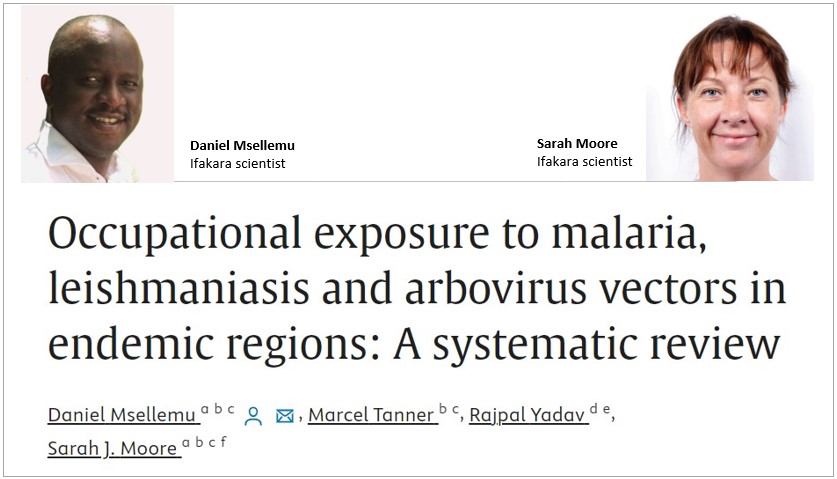
NEEDED: Targeted malaria interventions for high-risk populations

In a new malaria study, scientists have underscored the need for interventions specifically tailored to populations who are at high risk of vector exposure. These groups, which include outdoor workers and frequent movers (mobile population), are more likely to come into contact with disease-carrying insects due to their daily activities.
Published on the Science Direct journal, the study was led by Ifakara Health Institute scientists Daniel Msellemu and Sarah Moore, with contributions from Marcel Tanner of the Swiss Tropical and Public Health Institute (Swiss TPH) and Rajpal Yadav from the World Health Organization (WHO).
The scientists’ recommendation comes after conducting a systematic review to identify occupations and behaviors putting individuals at increased risk of vector exposure and find the best ways to protect them.
“This review aims to identify the different occupational risks of vector-borne disease, propose appropriate intervention for populations at higher risk of exposure to vectors of dengue, leishmaniasis and malaria; identify knowledge gaps; and establish an evidence base for best-practice guidance,” the scientists stated.
Analyzing data spanning 74 years
They analyzed studies published between 1945 and October 2021, sourced from 16 online databases. Out of 1,170 articles screened, 99 met the inclusion criteria, focusing on the incidence or prevalence of dengue, leishmaniasis, or malaria.
The scientists then categorized exposure into four main types: round-the-clock outdoor exposure, daytime outdoor exposure, indoor nighttime exposure, and outdoor nighttime exposure.
Identifying the most at-risk population
These categories helped identify the most at-risk populations, including mobile populations such as soldiers, refugees, tourists, and those living in semi-permanent settlements like migrant workers and refugees.
Soldiers were identified as the group with the highest frequency of infections, accounting for 38% of the studies reviewed. Other significant at-risk groups included refugees and travelers (15% each), migrant workers (12.5%), miners (9%), farmers (5%), rubber tappers and missionaries (1.8% each), and forest workers (0.9%).
Proposed interventions for different risk groups
Based on these findings, the scientists proposed intervention strategies for each group of the population.
Insecticide-treated clothing (ITC) was suggested as a potential intervention for outdoor exposure among mobile populations, protecting individuals lacking shelter, such as soldiers and refugees, as well as tourists in high-risk areas.
The method is also particularly promising for economically disadvantaged individuals, as it simply involves self-treating clothing to repel mosquitoes. However, further research and optimization are needed to improve its effectiveness.
“ITC is a favorable intervention for outdoor use…although its use can be impaired by partial adherence, particularly when short clothing is more commonly worn or where environmental conditions make the wearing of long clothing uncomfortable,” noted the scientists.
For populations living in semi-permanent settlements, such as migrant workers and refugees, multiple interventions tailored to their environments were recommended.
These methods include Indoor Residual Spraying (IRS) and Insecticide-Treated Nets (ITNs), or insecticide-treated hammock nets, which have shown the greatest efficacy for controlling malaria, leishmaniasis, and dengue in peridomestic settings.
However, Spatial Repellents (SR) which also hold promise for protecting against indoor biting mosquitoes in unimproved housing or forest shelters, were highlighted as effective measures.
Call for further research
The scientists emphasized the need for further research on vector exposure, particularly focusing on outdoor workers and mobile populations, as this is a critical yet understudied issue.
Additionally, they also urged for increased attention and resources to be directed towards studying vector exposure in vulnerable populations, such as refugees, fishers and farmers and those living in sub-Saharan Africa, where improved interventions are urgently needed.
“Although people occupationally exposed to vector-borne diseases, such as soldiers and travelers to endemic areas, may have a higher disease prevalence, the local population in the endemic area still experiences the largest absolute number of infections.”
“This highlights the need to address the issue of sustained control of vector-borne diseases in the local population in addition to supplemental control for occupationally exposed groups to control the spread of these diseases.”
Read the publication here.
